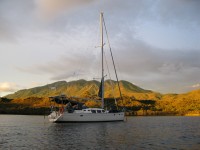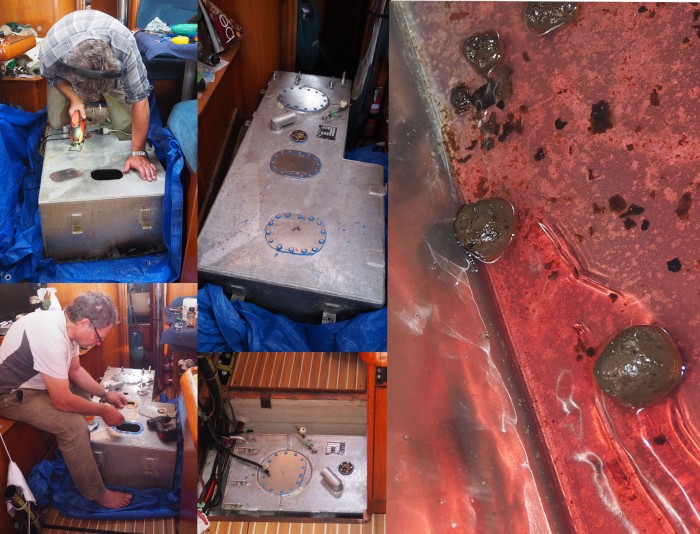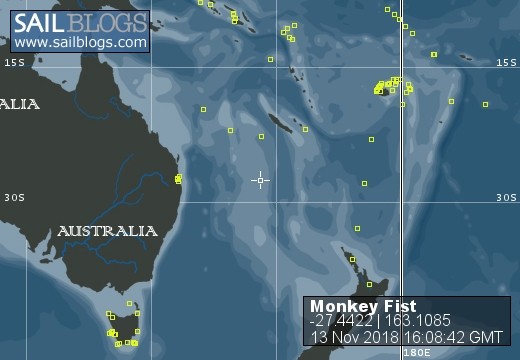
Monkey Fist

Who: Paul and Frances Tudor-Stack
Port: Darwin
Favorites
- Eyeglass Assist - Solomon Island Project
- OnTheNose
- PKA Products
- Lions Recycle For Sight
- Monkey Fist movie - Mexico to the Marquesas
- How to tie a Monkey's Fist
- Death in Paradise
- Raramuri
- Cruisers Comfort
- Diablo Canyon Nuclear Power Plant
- Fords Terror Time Lapse
- Galloping Gertie
- Gotz Guitar website
- Hawthorne Gallery
- Monkey Fist in Johnstone Strait
- Monkey Fist sailing in New Zealand
- Oki Islands, Japan - information
- Princess Louisa Inlet
- The Chichi Jima Incident
- Tsunami wave hits Brookings
13 November 2018 | Brisbane, Australia
04 November 2018 | On Passage - The Coral Sea, 480 MTG, 650 miles logged
28 October 2018 | Honiara, Solomon Islands
21 October 2018 | Shortland Islands, Western Province, Solomon Islands
18 October 2018 | Bay of 1,000 Voices, Choiseul., Solomon Islands
18 October 2018 | Bay of 1,000 Voices, Choiseul., Solomon Islands
15 October 2018 | Bay of 1,000 Voices, Choiseul, Solomon Islands
14 October 2018 | Pelau, Ontong Java, Malaita Province, Solomon Islands
14 October 2018 | Luaniua, Ontong Java, Malaita Province, Solomon Islands
14 October 2018 | Ontong Java Atoll, Malaita Province, Solomon Islands
03 October 2018 | Choiseul, Solomon Islands
02 October 2018
02 October 2018
02 October 2018
27 September 2018
27 September 2018
27 September 2018
27 September 2018
24 September 2018
24 September 2018
Bugs on the high seas
25 August 2016 | San Francisco Bay, California, USA

Non-sailors most likely have not heard the definition that cruisers assign to their chosen lifestyle : "Fixing your boat in exotic places". Very funny.
This is the part of cruising that taxes me most - fixing things. And it's not the fixing in itself that is so challenging, I do enjoy repairing things, however making repairs with limited tools, in limited space (with the whole boat pulled apart), difficulty in sourcing materials and/or parts and so on can significantly complicate things. Do this in a confined area and try to live in it at the same time makes such occurrences, shall I say, difficult.
Before you get to that repair stage of course you have a couple of steps to go through: -
The problem: it manifests itself. In this particular case the engine gave a couple of coughs and then stopped. After much bleeding we were able to start it again. The problem reoccurs not often, but once every few hours of motoring (due to no wind).
The diagnosis: - I think often this is the most difficult step is problem solving. It took some time to do so, but through a process of elimination we realized that it was a fuel starvation problem which caused by a blocked outlet pipe from the main fuel tank. When we were in Brookings we emptied the fuel from the tank, removed the tank, swirled it around and drained it. Two days of work later the problem was solved, or so we believed, until the engine stopped again. Back to the drawing board. By now we had found that in order to get the engine working again I had to remove the hose clamps from the outlet pipe and blow through it back into the tank and the problem was temporarily rectified. Having your engine stop at the wrong time, i.e. docking or going over river bars could result in disaster so it had to be fixed properly.
We knew the problem was within the main fuel tank and we needed to pull it out again and to look inside. Trouble was that our tank did not have any inspection holes, however we could remove the fuel gauge sensor and peek into one of the three separate internal chambers. We could see sludge in there which was expected but what we didn't expect was what appeared to be dome-shaped growths in there (the biggest was 2.5cm in diameter). Aliens. At some stage our tank has been infected by bacteria when we must have taken on infected diesel. This is a known issue with diesel and every time we take fuel on board we add a biocide specifically made to kill these organisms, obviously it has been ineffective. The organisms grow on the interface between the diesel and water which has collected at the bottom on the tank and obviously at least one had come become detached and had been floating around.
The resolution: So the tank had to again come out - Remove the diesel heater, backing plate, disconnect hoses, earth straps, floor sections, everything underneath the sink and pull the sucker out yet again. Then we had to cut inspection ports, one in each of the 3 chambers - all in the middle of our saloon (living room) floor. Clean the tank and then find somewhere to buy the materials needed to make the new covering and backing plates for the new ports. Fit the covering and backing plates, seal and reinstall everything in the reverse order. Oh what joy. All in all I estimate it took us 40 or 50 hours to do the job. Frances spent many hours cleaning out the tank as well as the metals shaving that escaped our tarp. She hates to miss out on the fun too. It cost us less than $100 to do the job so doing it ourselves saved us a considerable amount of money. Finally with the tank back in place we could have our boat back in one piece and we were back on our way.
This is the part of cruising that taxes me most - fixing things. And it's not the fixing in itself that is so challenging, I do enjoy repairing things, however making repairs with limited tools, in limited space (with the whole boat pulled apart), difficulty in sourcing materials and/or parts and so on can significantly complicate things. Do this in a confined area and try to live in it at the same time makes such occurrences, shall I say, difficult.
Before you get to that repair stage of course you have a couple of steps to go through: -
The problem: it manifests itself. In this particular case the engine gave a couple of coughs and then stopped. After much bleeding we were able to start it again. The problem reoccurs not often, but once every few hours of motoring (due to no wind).
The diagnosis: - I think often this is the most difficult step is problem solving. It took some time to do so, but through a process of elimination we realized that it was a fuel starvation problem which caused by a blocked outlet pipe from the main fuel tank. When we were in Brookings we emptied the fuel from the tank, removed the tank, swirled it around and drained it. Two days of work later the problem was solved, or so we believed, until the engine stopped again. Back to the drawing board. By now we had found that in order to get the engine working again I had to remove the hose clamps from the outlet pipe and blow through it back into the tank and the problem was temporarily rectified. Having your engine stop at the wrong time, i.e. docking or going over river bars could result in disaster so it had to be fixed properly.
We knew the problem was within the main fuel tank and we needed to pull it out again and to look inside. Trouble was that our tank did not have any inspection holes, however we could remove the fuel gauge sensor and peek into one of the three separate internal chambers. We could see sludge in there which was expected but what we didn't expect was what appeared to be dome-shaped growths in there (the biggest was 2.5cm in diameter). Aliens. At some stage our tank has been infected by bacteria when we must have taken on infected diesel. This is a known issue with diesel and every time we take fuel on board we add a biocide specifically made to kill these organisms, obviously it has been ineffective. The organisms grow on the interface between the diesel and water which has collected at the bottom on the tank and obviously at least one had come become detached and had been floating around.
The resolution: So the tank had to again come out - Remove the diesel heater, backing plate, disconnect hoses, earth straps, floor sections, everything underneath the sink and pull the sucker out yet again. Then we had to cut inspection ports, one in each of the 3 chambers - all in the middle of our saloon (living room) floor. Clean the tank and then find somewhere to buy the materials needed to make the new covering and backing plates for the new ports. Fit the covering and backing plates, seal and reinstall everything in the reverse order. Oh what joy. All in all I estimate it took us 40 or 50 hours to do the job. Frances spent many hours cleaning out the tank as well as the metals shaving that escaped our tarp. She hates to miss out on the fun too. It cost us less than $100 to do the job so doing it ourselves saved us a considerable amount of money. Finally with the tank back in place we could have our boat back in one piece and we were back on our way.
Comments
| Vessel Name: | Monkey Fist |
| Vessel Make/Model: | Jeanneau 43DS |
| Hailing Port: | Darwin |
| Crew: | Paul and Frances Tudor-Stack |
| About: | After spending over 20 years in the NT Paul and Frances returned to the sea in 2008. Their first trip was into the Pacific via West Papua and over the top of PNG and then back to Australia where they sold their old traditional boat "Sea Spray" and bought "Monkey Fist" |
| Social: |
Monkey Fist's Photos - Main
No items in this gallery.
Monkey Fist

Who: Paul and Frances Tudor-Stack
Port: Darwin
Favorites
- Eyeglass Assist - Solomon Island Project
- OnTheNose
- PKA Products
- Lions Recycle For Sight
- Monkey Fist movie - Mexico to the Marquesas
- How to tie a Monkey's Fist
- Death in Paradise
- Raramuri
- Cruisers Comfort
- Diablo Canyon Nuclear Power Plant
- Fords Terror Time Lapse
- Galloping Gertie
- Gotz Guitar website
- Hawthorne Gallery
- Monkey Fist in Johnstone Strait
- Monkey Fist sailing in New Zealand
- Oki Islands, Japan - information
- Princess Louisa Inlet
- The Chichi Jima Incident
- Tsunami wave hits Brookings

